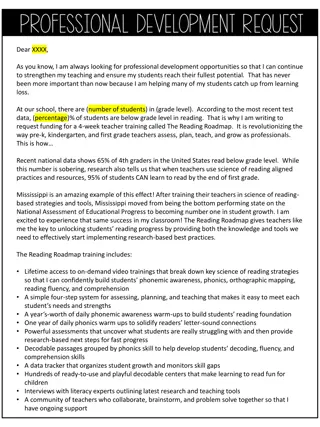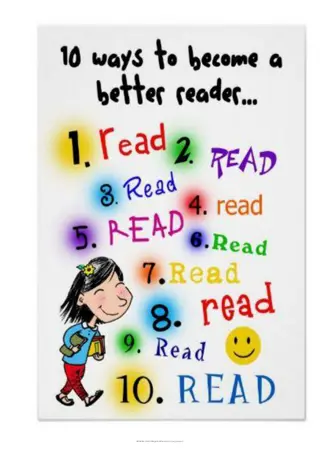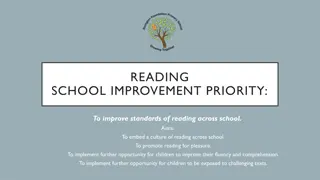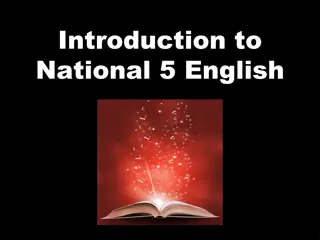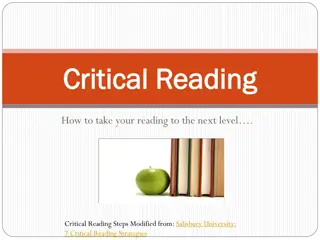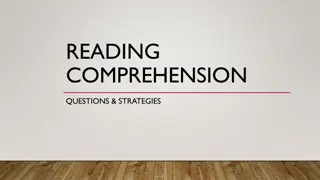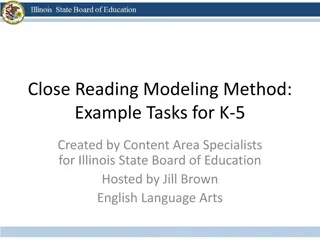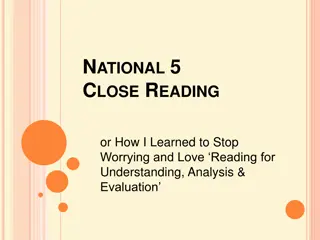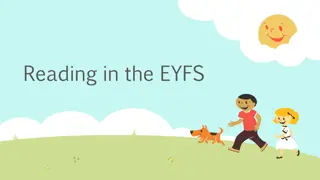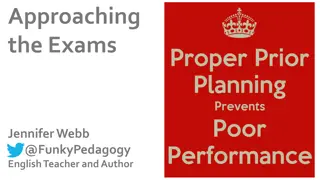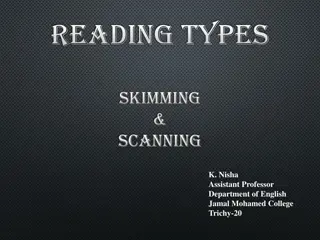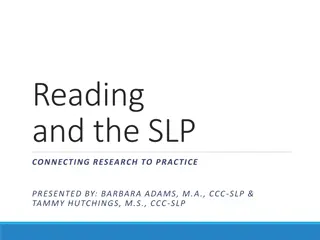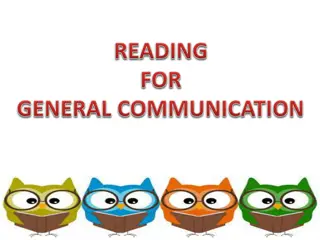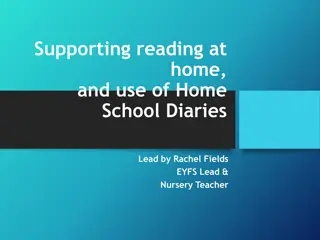Close Reading Techniques for National 5 & Higher Exams
Enhance your close reading skills for the National 5 and Higher exams. Explore tips on reading various genres, using your own words effectively, interpreting context questions, and more. Practice close reading to ace the exam!
Download Presentation

Please find below an Image/Link to download the presentation.
The content on the website is provided AS IS for your information and personal use only. It may not be sold, licensed, or shared on other websites without obtaining consent from the author.If you encounter any issues during the download, it is possible that the publisher has removed the file from their server.
You are allowed to download the files provided on this website for personal or commercial use, subject to the condition that they are used lawfully. All files are the property of their respective owners.
The content on the website is provided AS IS for your information and personal use only. It may not be sold, licensed, or shared on other websites without obtaining consent from the author.
E N D
Presentation Transcript
CLOSE READING GUIDE Preparing for RUAE at National 5 and Higher
Reading for Understanding, Analysis and Evaluation Otherwise known as Close Reading. You will be tested on this during your National 5 and Higher exam it is worth 30% of your final grade. If you re serious about passing, there s lots you can do to expand your experience of language. Try and read regularly. Include a range of genres, from novels to good quality newspapers such as the Guardian, Independentor The Times. Don t just read the front page read the features articles and opinion pieces too. Expand your knowledge of language, and of how people debate and argue about their ideas, by watching TV programmes such as Question Time and Newsnight. If you encounter unfamiliar words, see if you can work them out from the context, or look them up in a dictionary.
Using your own words Putting something in your own words shows that you have understood the meaning. The front of your exam paper will say attempt all the questions, using your own words as far as possible. Some questions might state in your own words but even if it doesn t you should still attempt to use your own words. Quoting or using words from the passage will not gain you any marks unless the question specifically asks you to quote. Using your own words means you might have to: Explain what a word or expression in the passage means. Explain what point the writer is making. Show that you understand a piece of information from the passage.
Context Questions You may be asked to work out from the context what a word or expression means. This is because the examiners think that you may not know the given word, but that you should be able to work it out from what surrounds it in the passage. You can learn a formula to help you answer these questions: The word/phrase _________ means _________. The context makes this clear as it says ____________________.
Here is an extract from later in the same news article about the employees with autism: At St Guy s and St Thomas hospitals in London, an initiative was set up two years ago to help people aged 18 to 30 with autism gain work experience. Staynton Brown, associate director of equality and diversity at the hospital, dismisses any suggestion of the initiative being a philanthropic one. This is not a charitable gesture, he said. We want to make sure we have the most talented workforce possible. It s in our interests in multiple ways. We ve all benefitted from the changes we ve incorporated to accommodate those with autism. By clarifying the way we give information to and help introduce the interns to the hospital, we ve made communication clearer for everyone, which leads to better patient care. How does the context of the second paragraph help you to work out what is meant by philanthropic ? Answer: the word philanthropic means done out of feelings of charity or solely for the good of others. The context of this makes it clear as the expression is followed with the idea that employing people with autism is not charitable .
Now try these: At St Guy s and St Thomas hospitals in London, an initiative was set up two years ago to help people aged 18 to 30 with autism gain work experience. StayntonBrown, associate director of equality and diversity at the hospital, dismisses any suggestion of the initiative being a philanthropic one. This is not a charitable gesture, he said. We want to make sure we have the most talented workforce possible. It s in our interests in multiple ways. We ve all benefitted from the changes we ve incorporated to accommodate those with autism. By clarifying the way we give information to and help introduce the interns to the hospital, we ve made communication clearer for everyone, which leads to better patient care. Show how the context helps you to understand the meaning of the word accommodate . 1. How does the context of these paragraphs help you to understand the word intern as it is used here? 2.
Show how the context helps you to understand the meaning of the word accommodate . 1. Answer: the word accommodate means to make allowance or adjustments for someone/ make it easy for someone to settle in. The context of this makes it clear because the passage refers to the idea/explanation of changes being made for staff with autism. 2. How does the context of these paragraphs help you to understand the word intern as it is used here? Answer: the word intern means a person working to get experience. The context makes this clear because there is a reference to work experience in paragraph 1.
Summarising Another key understanding skill is the ability to follow, and summarise, a key idea or line of thought running through a passage, or section of a passage. There will often be a summarising question at the end of the question paper to test that you have followed the argument of the writer. You don t need to give specific details, such as dates, numbers, names it should be more generalised. A good way to summarise is to use bullet points and keep your answers short. Referring to the whole article and the short extract, list in your own words the key advantages for employers in hiring staff who have autism. (4 marks)
Summarising -Answer They are focused on their work/the concentrate well They are honest They work thoroughly They pay attention to detail They think about the job even when they are not at work They have unique skills Their skills bring a measurable benefit to their employers They have good analytical skills They will work even better if their job coincides with an area of special interest They are good timekeepers They are rarely off work They are loyal They will enjoy jobs which others find boring They are ideally suited for work in the service industry/work which is repetitive and structured.
Word Choice When we talk about word choice as a technique, we mean that certain words are deliberatelychosen to create a particular effect or to suggest something in particular. Words have two different meanings: DENOTATION basic, straightforward meaning. It s what you would find if you looked a word up in the dictionary. CONNOTATION is what the word suggests or implies. What does it make you think of? ATE GOBBLED NIBBLED RAN BOLTED SPRINTED THIN SKINNY SLIM
Word Choice Identify the word What is the denotation? What are the connotations? Look at this worked example of a word choice question: Q: Explain how the writer s word choice in paragraph 1 helps to show the ganceros job is tiring. A: hauling describes them moving the bags of rubbish. It suggests the bags are heavy or awkward to move, which would make this job exhausting.
Imagery Writers use imagery to strengthen what they are saying by creating a picture in the reader s mind. They use imagery to show the way one thing is like another. It s not the same as a description, which tells us what something is like, or word choice. Ask yourself what is being compared to what and identify the technique (simile, metaphor, personification ) Think about how the two things being compared are similar and show that you understand how the writer uses this to make a point.
Imagery Define the following features of imagery and give an example: Simile - Metaphor - Personification -
Imagery Define the following features of imagery and give an example: Simile -a comparison using like or as He was as happy as a clam. Metaphor - comparing one thing to another by saying it is that thing. A metaphor is not literally true, but it implies that the two things share a particular characteristic. He is a vicious animal. Personification -representing a non-human thing as if it were human. My computer throws a tantrum every time I try to use it.
Answering Imagery Questions Identify the image (what technique?) What two things are being compared? What is the effect/ what does this suggest? IMPORTANT STEP!
Answering Imagery Questions The boy ran the race like a cheetah. The writer has used a simile to compare the boy to a cheetah. Just as a cheetah is a fast, predatory animal, so too the boy is quick and powerful. The simile emphasises his speed.
Answering Imagery Questions She was an angel. The writer has used ametaphor to compare the girl to an angel. Just as an angel is a biblical being who does good and is helpful, so this suggests the girl is kind and innocent. This metaphor emphasises the girl s purity.
Answering Imagery Questions He has a mountain of homework to do. The writer has used ametaphor to compare the homework to a mountain. Just as a mountain is large and challenging to climb, so the amount of work he has to do is enormous and will be difficult. This metaphor emphasises the struggle it will take to do the homework.
Link Question You may be asked a link question. These often ask you to say how a sentence creates an effective link between one paragraph and another. These questions are normally worth two marks and you have to answer them in two parts: Show how one part of the sentence links back to the previous paragraph. Show how another part of the sentence refers forward to the new paragraph. 1. 2. You can use the following formula to do this: The word/phrase ________ links back to ________, which was discussed in the previous paragraph. The word/phrase ________ introduces the idea of ________, which is explored in the next paragraph.
Link Question Summarise previous paragraph(s). Summarise next paragraph. Look back at the link sentence. Pick out a word or a phrase (3 words at the most) that connects back to the previous point. Use your summary to help you! Repeat, this time looking for a word or phrase that connects forward. 1. 2. 3. 4. The word/phrase ________ links back to ________, which was discussed in the previous paragraph. The word/phrase ________ introduces the idea of ________, which is explored in the next paragraph.
Link Question Re-read paragraphs 8 and 9 of the passage about computer curfews. How does the sentence Needless to say, my efforts to explain this to my daughter were pretty hapless. form a link between paragraphs 8 and 9? Answer: The phrase to explain this links back to the harmful effects of always being connected as discussed in paragraph 8. The phrase my efforts introduces the writer s attempt to explain the value of having an interior life, which is discussed in paragraph 9.
Tone Questions It is easy to understand what we mean by tone if we think about the way someone speaks. When you hear someone s voice, you can usually tell if they are angry, confused, excited or afraid. You create tone when you speak through volume, the speed of speech, which words you put emphasis on and how fluently / hesitantly you speak. It is harder to identify tone in written English, but skilled writers can create tone through word choice alone. Tone questions can be answered using a mixture of the following, depending on the question: Identify a tone. Quote words/phrases which create that tone. Explain how the words/phrases you have quoted create the tone.
Tone Questions The following extract comes from the article on babysitting toddlers: Twins poo at the same time, who knew? How does the writer establish a tone of surprise in this sentence? She does so by stating a surprising fact: Twins poo at the same time. She also adds a rhetorical question: who knew? to point out that the fact is unexpected.
Tone Questions The following extract comes from the article on babysitting toddlers: I want to put you through this in real time, but I ve got to pick peas out of the weave of my carpet. What is the tone of this sentence, and how is it created? The tone is one of exhaustion. It is created by the author describing a task she still has to do: pick peas out of the weave of the carpet.
Sentence Structure Questions Sentence structure is how a sentence is made and built up. Very often, candidates get structure questions wrong because they do not actually answer the question. Many end up rehashing the content of the sentence when they should be examining its structure. Structure is not the same as content. The structure of a house might be bricks and mortar placed on strong foundations. The content would be the furniture and people. The structure of your school bag might be canvas, stitched together. Its content would be your books, jotters, pens and phone.
Sentence Structure Questions A number of smaller techniques contribute to sentence structure: Length: look at whether a sentence is noticeably long or short, especially if its length contrasts with that of sentences nearby. Listing: what is being listed and what does this list suggest? Repetition: what is being repeated and what does this suggest? Parenthesis: what is the extra information inside the parenthesis about and what is the effect of this? Word order: have any words been put in a position in the sentence that particularly creates emphasis? Colons or semi-colons: what do these divide the sentence into? What do colons introduce? Minor sentences: these ungrammatical (usually short) sentences are used to create some kind of impact, so what impact is it? Questions: what is the effect of these on the reader?
What the examiner is looking for 1. Identify the feature of sentence structure. 2. Comment on the effect it has. Why has it been used? Depending on how many marks the question is worth, you must provide one feature/effect for each mark.
Example Fog everywhere. Fog up the river, where it flows among green airs and meadows; fog down the river, where it rolls defiled among the tiers of shipping, and the waterside pollutions of a great (and dirty) city. Fog on the Essex marshes, fog on the Kentish heights. Fog creeping into the cabooses of collier-brigs; fog lying out on the yards, and hovering in the rigging of great ships; fog drooping on the gunwales of barges and small boats. Q. Discuss the effectiveness of the sentence structure in this extract.
Sentence Structure Questions Look at paragraph 2 in the passage about life in 2033. How does the sentence structure of this paragraph contribute to a conversational tone throughout? 1. The writer repeatedly uses you or your at the start of sentences. This creates the impression that they are talking directly to the reader. Show how the structure of the second sentence suggests that technology will make future life straightforward. 2. The writer lists a number of things we will be able to control: temperature, humidity, ambient music and lighting . This suggests that everything in life will be easily controlled, and that life will therefore be straightforward.
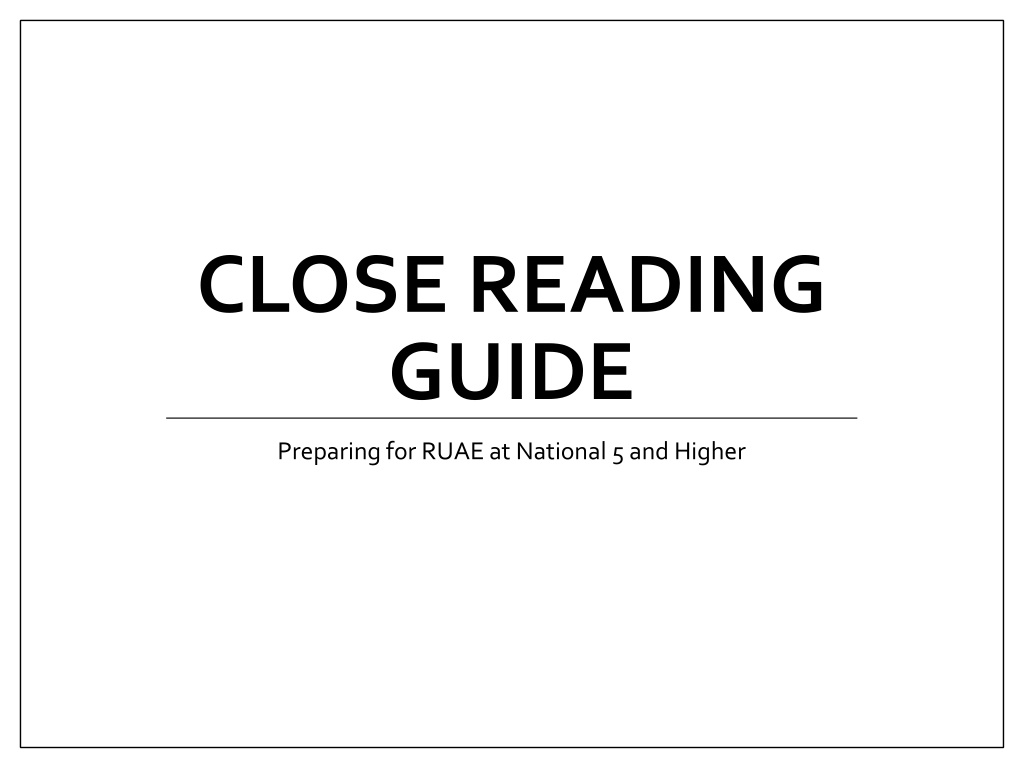
 undefined
undefined





